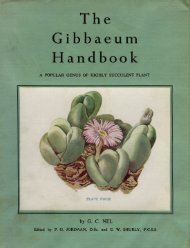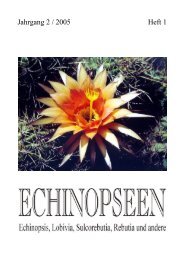journal
journal
journal
Create successful ePaper yourself
Turn your PDF publications into a flip-book with our unique Google optimized e-Paper software.
6 THE CACTUS AND SUCCULENT January, 1951<br />
THE SCIENTIFIC APPROACH TO SUCCULENTS<br />
Champions of fact, fad and fable<br />
By GORDON D. ROWLEY<br />
INSTALMENT ONE<br />
The news of the formation of an International Organisation for Succulent Plant Research—news that will be<br />
welcomed by all seriously interested in the study of succulents—re-opens the old thorny question of the relations<br />
between the scientist and the amateur grower. For years a gulf between them has been apparent, and at worst<br />
this has led to harsh words and isolationism on behalf of just those parties that should be working hand in hand.<br />
The amateurs, forming the vast majority, saw no inducement to attempt to understand the savants, whom they<br />
regarded (often quite justifiably) as incomprehensible and out of touch with any such down-to-earth everyday<br />
topics as plant cultivation. The scientists, for their part, grew cliquish and looked down their learned noses at<br />
anything that had not the official sanction of a University or Research Station. Shall the twain never meet ?<br />
My interest here is two fold. I want, first, to show that both scientist and amateur have something to offer<br />
each other ; that by joining forces their joint effort would be more than merely the sum of the two parts put<br />
together. Then, second, I want to suggest how you,—yes, even the humble grower with a tiny glasshouse—can<br />
make real contributions to the study of succulents if you have but three qualifications ; time, patience, and the<br />
enthusiasm to learn.<br />
First Impressions ; The dark ages<br />
If one looks into the history that lies behind succulent growing in England today, or makes any attempt to<br />
assess how much is reality and how much old wives' tales in current literature, one fact stands out pre-eminently.<br />
It is that the amateur, not the scientist, laid the foundations, ran up the walls, and very nearly tiled the v/hole roof<br />
of our present day knowledge of these most curious plants. In cultivation, at least, practically all our notions go<br />
back to the Smiths and the Joneses who killed a hundred plants in growing three successfully on their sitting-room<br />
window sills or conservatory shelves.<br />
The Scientist<br />
On the other hand, in botanic gardens, universities and research stations no group of plants has been more<br />
neglected, and hence none has lagged farther behind in specialist treatment. The reasons for this, so far as any can<br />
be assigned, are obvious to those with a little experience of growing these plants. They have, to begin with, the<br />
initial and largely false reputation of being difficult to grow. Some, undoubtedly, are. Others are so amenable<br />
to glasshouse treatment that they are every bit as difficult to kill. Then they lack the utilitarian value of the potato,<br />
and the obvious voluptuous gorgeousness of the rose ; theirs is a much more subtle beauty that is often only fully<br />
realised when one has lived with the plant all the year round. Again, because many are so prolific and multiply<br />
so freely, they escape that " rarity complex " that enshrouds the orchids, which are collectors' pieces from the<br />
moment their fungal partner launches the seedling into its perilous and fragile existence. Finally—and this is<br />
perhaps the most potent influence of all in bringing disfavour on succulents—they never know when they are<br />
beaten. Where every other greenhouse plant succumbs to drought, overcrowding, suffocation and starvation,<br />
the Cactus lives on, wrinkling with age and adversity like some embittered hermit to a ghastly skeleton of living<br />
death, expressing in every gnarled deformity the torment of a hostile world. The result ? That collections<br />
everywhere are cluttered up with these veteran warriors, and the public at large sees no reason to change its belief<br />
that Cacti are the freaks of the vegetable world ; nature's little legpull for all the other beautiful things she has<br />
provided. A succulent collection can, after a remarkably short period of neglect, lose its sparkle and freshness ;<br />
if the plants died, no one would be any the wiser, but they do not—they go on, unless a rare benefactor again takes<br />
them in hand, to shout aloud for the rest of their days the struggles of their youth.<br />
So much for the scientist ; our duty to him lies clear. We must build up and publicise collections of such<br />
high quality, authenticity and clean condition that he will be attracted to grow and study them.<br />
The Amateur<br />
Now for the amateur—what of his rights and wrongs ?<br />
I have already handed him a bouquet for so much donkey-work in building up our knowledge of succulents<br />
in cultivation, but how much of that knowledge will stand the test of experiment ?
















